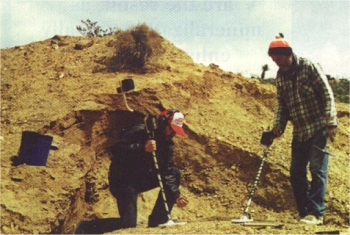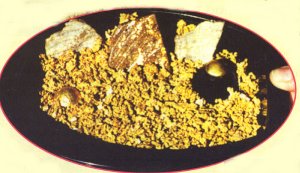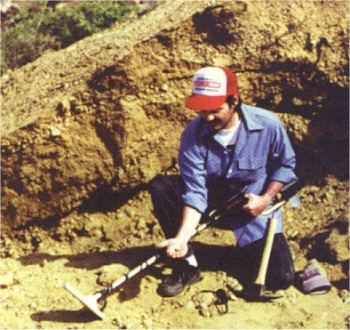By David R. Toussaint
“Your metal detector doesn’t find the gold,” he told me. “You find the gold and then you put your metal detector over it.”
 I met Don Gaines in late 1994, and he changed the way I think about gold hunting. Gaines, a retired Navy technical instructor, has found hundreds, maybe thousands, of gold nuggets by working the ore dumps from old gold mines with a metal detector.
I met Don Gaines in late 1994, and he changed the way I think about gold hunting. Gaines, a retired Navy technical instructor, has found hundreds, maybe thousands, of gold nuggets by working the ore dumps from old gold mines with a metal detector.
“Huh?” I said. “Find the gold first, and then put your metal detector over it,” Don repeated patiently.
I wondered if this was just a variation of the old “gold-is-where-you-find-it” saying, or if it was really something new. As we talked, I began to see what he meant. To find gold, you have to know at least one of three things:
1) Where the gold is (if you know this, your success is guaranteed-duh!).
2) The rock formations associated with gold (a degree in geology helps).
3) Where gold has been found before (this only works sometimes).
Then a light bulb went on in my head. I already knew where the gold is and where it had been found before. I didn’t need a degree in geology to find it. Gaines had already found it in an ore dump near an old gold mine in southern Nevada. Why wander the desert hunting for placer deposits or pocket gold when I already knew where the gold was? This was no time to be timid!
“Do you think I can come out and hunt that ore dump with you some time?” I asked boldly. “Sure, it’s all right with me,” replied Gaines. “But you’ll have to get the permission of Harley, the mine owner. It’s his mine, on his private property. I’ve worked out a deal with him where he lets me keep half the gold that I find. Maybe you could work out the same kind of deal. Oh yeah, don’t forget to bring along a case of beer for Harley.”
 Four months later, I sat in Gaines’ four-wheel drive, looking across a sage-brush canyon at the mouth and head-frame of an old mine. Right there, next to a gravel road, was a sign that read, “PRIVET PROPERTY, KEEP OUT.” I didn’t know if the incorrect spelling was intentional or not, but it sure was effective. I had to wonder what kind of dangerous red neck could have written it.
Four months later, I sat in Gaines’ four-wheel drive, looking across a sage-brush canyon at the mouth and head-frame of an old mine. Right there, next to a gravel road, was a sign that read, “PRIVET PROPERTY, KEEP OUT.” I didn’t know if the incorrect spelling was intentional or not, but it sure was effective. I had to wonder what kind of dangerous red neck could have written it.
There was a case of beer in the trunk. Across the shallow canyon, I could see two large ore dumps on the side of the mostly-barren hillside, both showing flattened-out spots where Gaines had been working them. About 200 feet to the left of the ore dumps was a house partly concealed by trees.
“That’s Harley’s house,” Gaines said, pointing across the canyon. “His father built it when he came out here around 1910. Harley’s father was in Goldfield for the strike there. He made some money and came here. See that big head-frame farther east?” Gaines asked, pointing at a brown dot on the hill about a mile away. “Harley’s father knew there was gold here because of that gold mine.” Sweeping his arm across the horizon, Gaines continued, “He filed a mining claim on this section next to it and hired an outfit to sink a shaft. About 100 feet down, they hit the vein that connected to that other mine.”
 So, Harley’s father had known where the gold was, I thought; and that’s where he went to go find it. Of course, 90 years ago he did not have a metal detector to prospect with. Because of that, he missed many of the smaller nuggets. Most of the large rocks from the vein were crushed and the low-grade material was cast off in the ore dump.
So, Harley’s father had known where the gold was, I thought; and that’s where he went to go find it. Of course, 90 years ago he did not have a metal detector to prospect with. Because of that, he missed many of the smaller nuggets. Most of the large rocks from the vein were crushed and the low-grade material was cast off in the ore dump.
Harley knew we were coming; Gaines had already called him from his cellular phone. This was probably a good thing. Later on, I asked Harley if he shoots at trespassers.
“No, I don’t shoot at them,” he said without a smile. “I shoot them.” “Oh, you mean you hit what you aim at?” I asked with a laugh. “That’s right,” Harley replied with a wry look. I decided not to press the matter any further.
Harley told me he had grown up in Chicago, just a few blocks from the spot where the notorious gangster John Dillinger was slain by the FBI. I found myself liking these independent desert dwellers. Harley gave me the same deal he had given to Don: He would allow me keep half the gold that I found. He would also keep the case of beer.
The next day dawned clear and bright with only a little wind. We were out on the ore dump early with pick, shovel and our metal detectors. I was using a new Gold Bug-2. I was curious to see how well the Iron-discrimination circuitry worked, how the 71-kHz operating frequency behaved and if the faint-target audio-boost could find smaller, deeper gold nuggets .
To get started, Don showed me his method of working the ore dump. On a flat area about 20-feet wide near the base of the dump, he threw out shovelfuls of the pale-yellow dump material. The dirt and rock seemed to leap from his shovel and spread itself evenly out about two inches deep over the flat area. “He’s done this before”, I thought to myself.
Wasting no time, Don picked up his detector and checked the larger rocks for gold. One gave him a signal, and he set it aside with some other large rocks. These he would crush later. Then he started tossing the other large rocks from the flat area; but instead of using his hands, he used his feet! The rocks started leaping from his lightweight running shoes like bullfrogs from a lily pad. Any soccer player would have been impressed. In no time, he had the flat area cleared of large rocks, and he began swinging his detector rapidly over the spread out dirt material.
“That’s a pretty fast swing,” I commented. “I get a sharper signal when I swing it fast,” Don replied. “You know, there is no right way to use a metal detector. The only right way is the way that works for you.” He soon knelt down, held the detector-stem in his left hand, grabbed a hand pick from his belt with his right and dug a small hole. Carefully making a small pile with the excavated dirt, he swept his detector coil over it. Hearing no signal, he rechecked the hole, and then ran a large cow magnet through it. The magnet protruded from the butt-end of his pick. After a few checks of the growing pile of dirt, Don must have located the target, because he grabbed a handful of dirt from the pile. Still holding the detector by the stem with his left hand, he started pouring small handfuls of dirt on top of the search coil with his right hand, jiggling the coil slightly to make the target sound off. After a few handfuls of dirt had fallen off the search coil, he heard the target and poked around in the dirt on top of his search coil with his index finger.
As soon as Don had the target in his hand, his hand flew away from the coil and a small piece of something flew away toward a large pile of rusty tin cans and other junk beyond the ore dump. I figured it hadn’t been a gold nugget. “It was a piece of blasting cap,” Don said. “It’s made of brass and it sounds just like gold.” “Can I see the next piece of blasting cap you find?” I asked. “So I know what it looks like.” “Sure,” replied Don. “These tiny pieces of blasting cap are all over. When the old- timers dynamited the vein, the blasting caps disintegrated and the pieces went everywhere.”
A few minutes later, Don found another piece of blasting cap and showed it to me, taking a short time out from the steady, unhurried pace he had set on the dump. It looked like a small, twisted piece of copper that had turned dark green from age. It joined the other junk in the junk pile. A few more pieces of junk; a rusty nail, a piece of tin can and a tiny piece of rusty wire emerged from the ore material and were quickly discarded.
Don spread another pile of the ore-dump material out on the flat area and let me search this one with the Gold Bug-2. After checking the large rocks, I swung the detector a few times over the dirt. In no time, it went “WHAM!” I flipped on the iron discrimination and it still went “WHAM!”
“Hot dog,” I thought, “This sounds like gold.” I pinpointed the target, knelt and started pouring dirt on the head of my search coil. “WHAM!” went the detector again. Gingerly, I poked around on the top of the coil until I moved the target. Certain I had a gold nugget, I poked a tiny piece of twisted dark metal and heard another “WHAM” in my headphones. I had found my first piece of brass blasting cap, the first of many I was to find.
“I usually find about 20 pieces of junk for every nugget I find,” Don said consolingly.
I kept swinging the search coil and digging junk targets until Don stopped me. “Hurry up,” he said. “Dig only the targets that sound good to you. To find gold you have to move material.”
Once again, I covered the flat area with more material, checked the big rocks and began swinging the detector. I soon heard another “WHAM” in the headphones. The signal sounded good, “probably just another piece of blasting cap,” I thought. I hunted the target down and found a rock about the size of your thumb from the last joint on. It felt a little heavy. I brushed off some of the brown dirt and saw a dull, yellow color gleam through. I was stunned. I didn’t know what to think. I couldn’t believe that I had finally found a gold nugget. What’s more, this was a good-sized one! “Don, look at this,” I said, tossing him the nugget. Don looked at it, rubbed it, spit on it, rubbed it some more and declared it a good find. “There you go,” he exclaimed. “Your first gold nugget. Let’s get a picture with you holding it.”
The nugget weighed about 2 grams, and it contained beautiful white bull-quartz, a really nice specimen. Later, we soaked it in a solution of hydrofluoric acid overnight; and in the morning, the quartz/gold nugget gleamed like a beautiful woman’s smile. I decided to make a pendant out of it for my wife Julie.
Although the first one was the largest, it wasn’t the last gold nugget I was to find during my week-long stay in southern Nevada. Dividing my time between the ore dump and the casinos, I was able to take about 20 grams of gold from the dump, of which Harley generously kept a little less than half. My take wasn’t enough to make me rich, or even pay for the trip, but it was enough to make me happy. Before I left the old mine, I buried a 12-pack of beer on the dump where I knew Don would be searching for gold. Later, he told me he got a good laugh when he found it, but I think he got a bigger laugh out of teasing me. He told me he had found a large gold nugget just below the 12-pack after he dug it out. Don doesn’t usually kid around too much, but this time I think he was fooling, or at least I hope he was.
Back on the job, as I sit at my desk, I often think about Don working the ore dump in the vast open spaces of southern Nevada. He once told me the first step to becoming a successful gold hunter is to retire, and I can see he’s right. The second step, of course, is to look where the gold is.
I now have an open invitation to return to southern Nevada and work the ore dump just about any time I want. Chances are I’ll return there someday. I’ve learned my lesson: Why waste time searching the desert in places the gold might be when I already know where it is?





